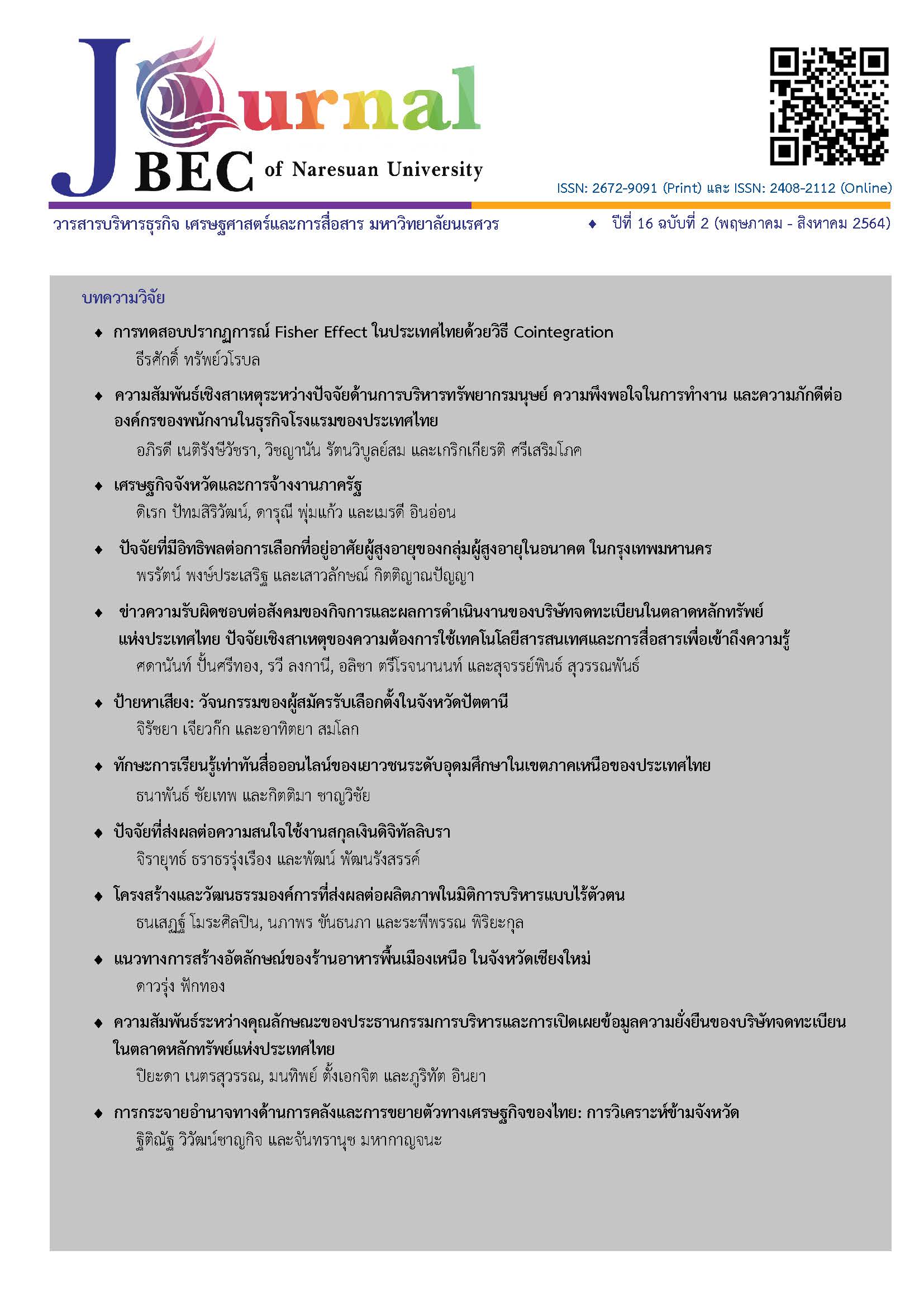An Empirical Investigation of the Fisher Effect in Financial Market and Government Bond Market in Thailand: A Cointegration Approach
Main Article Content
Abstract
This study aimed to examine the Fisher Effect in money market and bond market under the regime of flexible inflation targeting in Thailand. The monthly time series data during 2005-2018 were utilized to examine long-term relationship using Johansen methodology as well as to investigate the speed of adjustment using VECM method. Thai 1-year and 10-year bond yields as well as interbank rate were utilized as proxies of interest rates in bond and money market, respectively, whereas headline inflation rate was used as a proxy of expected rate of inflation following Rational Expectation Approach. The results showed the long-term relationship between the expected rate of inflation and nominal interest rate in both bond markets and money market in all cases. In addition, when there was any shock in nominal interest rate, the system would bring nominal interest rate back to its long-run equilibrium within 2-3 months. The results also showed that all effect of changes in the expected rate of inflation could passthrough into nominal interest rate, providing empirical evidence that the Fisher effect held in both money market and bond market.
Article Details
References
Atkins, F. J. (1989). Co-integration, error correction and the Fisher effect. Applied Economics, 21, 1611-1620.
Benazic, M. (2013). Tesing the Fisher Effect in Croatia: an empirical investigation. The 6th International Conference. The Changing Economic Landscape: Issues, Implications and Policy Options, 83-102.
Bonham, C. S. (1991). Correct cointegration tests of the long-run relationship between nominal interest and inflation. Applied Economics, 23, 1487-1492.
Caporale, G. M. And Pittis N. (2004). Estimator choice and Fisher’s paradox: a Monte Carlo study. Econometric Reviews, 23(1), 25-52.
Caporale, G. M. and Gil-Alana, L. (2017). Testing the Fisher Hypothesis in the G-7 countries using I(d) techniques. DIW Berlin Discussion Papers, No.1667.
Crowder, W. J. and Donna L. H. (1996). The long-run relationship between nominal inter¬est rates and inflation: the Fisher equation revisited. Journal of Money, Credit, and Banking, 28(1996), 102-118.
Cooray, A. (2003). The Fisher effect: a survey. Singapore Economic Review, 48, 135-150.
Culver, S. E. and Papell D. H. (1997). Is there a unit root in the inflation rate? Evidence from sequential break and panel data models. Journal of Applied Econometrics. 12(4), 436-444.
Dickey, D. A. and Fuller W. A. (1981). Likelihood ratio statistics for autoregressive time series with a unit root. Econometrica, 49(4), 1057-1072.
Elliott, G. (1998). On the robustness of cointegration methods when regressors almost have unit roots. Econometrica, 66(1), 149-158.
Fama, E. F. (1970). Efficient capital markets: a review of theory and empirical work. Journal of Finance, 25, 383-417.
Fama, E. F. (1975). Short-term interest rates as predictors of inflation. American Economic Review, 65, 269-282.
Fatima, N. and Shamim A. S. (2012). Empirical evidence of Fisher Effect in Pakistan. World Applied Sciences Journal, 18(6), 770–773.
Fisher, I. (1930). The theory of Interest, as determined by impatience to spend income and op¬portunity to Invest it. New York: The Macmillan Company.
Gibson, W. E. (1970). Price-expectations effects on interest rates. Journal of Finance, 25, 19-34.
Ito, T. (2016). Does the Fisher Hypothesis hold in Sweden? An analysis of long-term interest rates under the regime of inflation targeting. Review of Integrative Business and Economics Research, 5(3), 283-295.
Johansen, S. (1988). Statistical analysis of cointegration vectors. Journal of Economic Dynamics and Control, 12(2-3), 231-254.
Johansen, S. and Juselius, K. (1990). Maximum likelihood estimation and inference on cointegration with applications to demand for money. Oxford Bulletin of Economics and Statistics, 5(2), 169-210.
Kittithamchariya, S. (1997). Testing Fisher Effect: a case of Thailand, Thesis, M.Econ., Chulalongkorn University, Bangkok.
Mishkin, F. S. (1992). Is the Fisher effect for real?. Journal of Monetary Economics, 30, 195-212.
Rehman, H. U., Khan, S. and Ahmad, I. (2004). Does Fisher Effect exist in Pakistan? A cointegration analysis. Pakistan Economic and Social Review, 42(1), 21-37.
Yohtchaisarn, S. (2001). An analysis of the relationship between interest rate and inflation in Thailand: a case study of Fisher Effect, Thesis, M.Econ., Ramkhamhaeng University, Bangkok.
Zainal, N., Nassir, A. M. and Yahya, M. H. (2014). Fisher Effect: evidence from money market in Malaysia. Journal of Social Science Studies, 1(2), 112-124.

